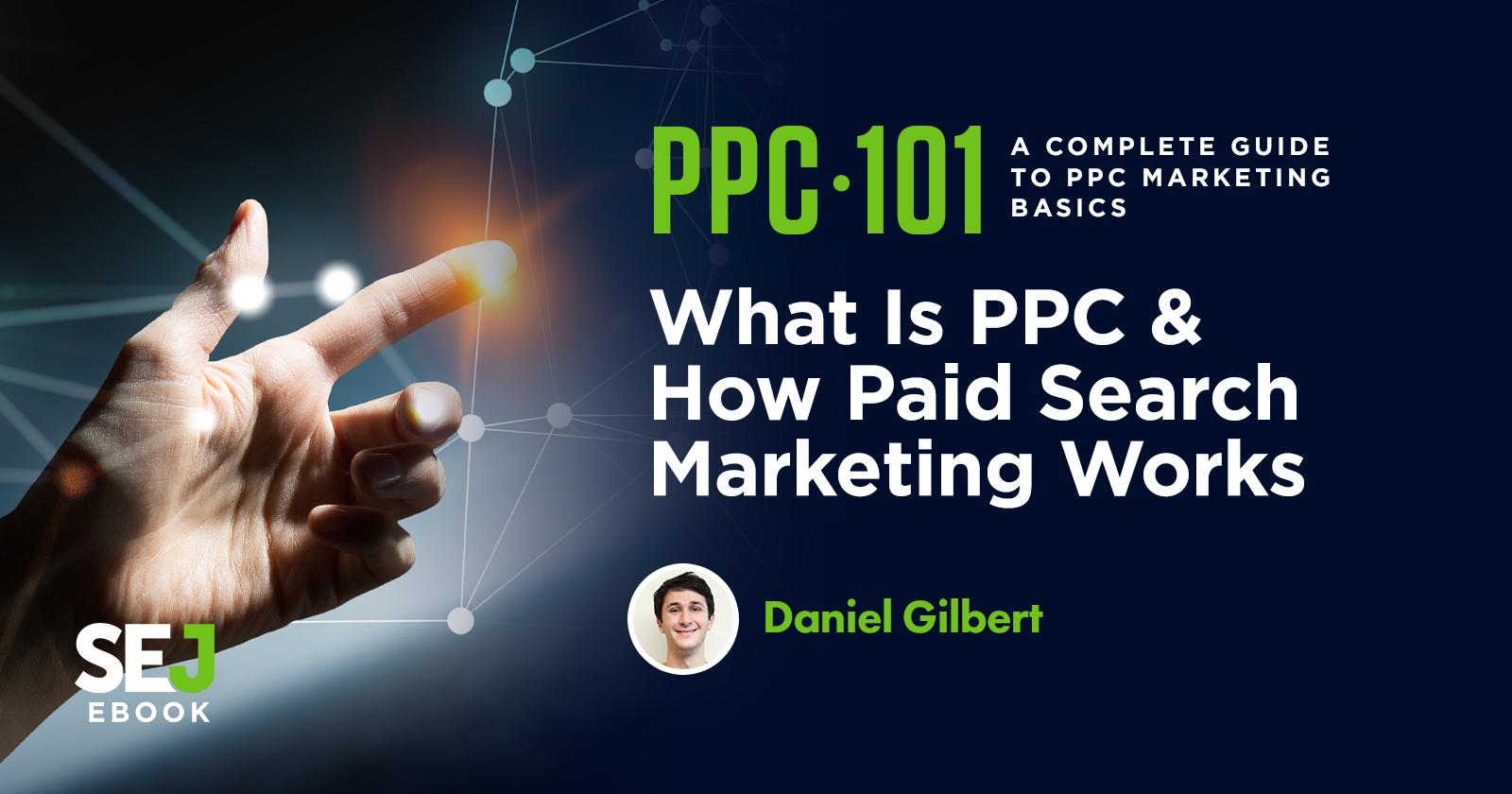What is PPC?
How does it work?
And, most importantly, how can you make it work for you?
This chapter will introduce you to everything you need to know about the exciting world of paid search marketing: keywords, ads, budgets and bids, ad rank, targeting, and conversions.
Let’s kick things off with the basics.
What Is PPC?
Pay-per-click (PPC) is an advertising model that lets advertisers place ads on an advertisement platform and pay the host of the platform when their ad is clicked.
The goal of the ad is to lead the user who clicks to the advertiser’s website or app, where the user can complete a valuable action such as purchasing a product.
Search engines are popular host platforms as they allow advertisers to display ads relevant to what users are searching for.
Advertising services like Google Ads and Microsoft Ads operate with real-time bidding (RTB), where advertising inventory is sold in a private automated auction using real-time data.
How Paid Search Works
Every time there is an ad spot on a search engine results page (SERP), an auction takes place for the keyword instantaneously.
A combination of multiple factors, including bid amount and the quality of the ad, decide the winner who will appear in the top position.
These auctions are what keeps the gears of PPC moving. They begin when someone searches for something on a search engine.
If there are advertisers interested in showing ads related to a user’s search query, an auction is triggered based on keywords that are bid on by advertisers.
The ads that win the auction then appear on the search engine results page.
To get involved in these auctions, advertisers use accounts on platforms like Google Ads to set up their ads and determine where and when they would like those ads to appear.
Accounts are split into campaigns for ease of management and reporting of different locations, product types, or other useful categorization.
Campaigns are further divided into ad groups that contain keywords and relevant ads.
Keywords
Keywords lie at the center of PPC, connecting advertisers to users’ search queries.
- Queries are the actual words that users type into the search box of a search engine to find results.
- Keywords, on the other hand, are what marketers use to target these users by matching their search queries.
Keywords work as generalized abstractions of a wide range of search queries prone to irregularities like misspellings.
Depending on the keyword match types they use, advertisers can match search queries with more or less precision.
For example, advertisers can choose to match keywords with search queries exactly or to allow for variations such as different orderings of the words, different spellings, or the inclusion of other words.
It is also possible to have negative keywords, which will prevent ads from being triggered by search queries containing those keywords, to avoid irrelevant traffic.
Ads
Along with keywords, advertisers need to prepare ads in their campaigns.
These are nestled together within ad groups that target shared sets of keywords and are organized by common themes.
Ads are what the users will see if the auction is won, so they’re essential to get right.
They typically contain headlines, description lines, and a URL.
On a SERP, they can show up on top of the results or at the bottom of the page.
It’s good practice to test different versions of ad copy to see what performs best.
Services like Google Ads and Microsoft Ads provide features called ad extensions that enhance the appearance of ads.
Examples include sitelink extensions, which populate an ad with more links to different pages on a site, and call extensions, which add a phone number to the ad during business hours.
Ad extensions are great as they increase the visibility of ads by making them more engaging to users while communicating more information.
Budgets & Bids
To participate in the auction, advertisers need to decide how much they’re willing to spend on a given keyword.
This is done using budgets at a campaign level and bids at the ad group or keyword level.
Budgets are set at the campaign level and can be exceeded daily, but will not be overspent monthly.
Budgets should be set according to the overall account strategy, but bids are a more precise way of controlling spend.
All ad groups must have bids, but keyword-level bids override ad group level bids.
Many advertisers use automated bidding strategies.
These allow advertisers to set a specific goal for their campaigns and then have the advertising platform determine the most appropriate bid for each auction.
Bid strategies can be applied to individual campaigns or a portfolio of multiple campaigns.
Due to the RTB system, the actual amount paid by the advertiser is dependent on competitor activity and ad rank, not just the maximum bid.
Ad Rank
There’s more to winning the auction than having the highest bid.
Search engines look at other factors to determine which ads should be at the top and most valuable spot on the SERP.
Search engines have their own particular ways of factoring in other elements to determine ad rank.
Google, for example, considers:
- Bid amount.
- Ad relevance and quality.
- The context of the search (such as the user’s device and time of day).
- Format impact (e.g., whether it includes extensions that enhance the format of the ad).
Quality Score is a metric that determines ad relevance.
The components of Quality Score are:
- Historical click-through rate (CTR).
- The relevance of the keyword to the ad.
- The relevance of the keyword and ad to the search query.
- Landing page quality.
Ad relevance is absolutely essential; the higher the Quality Score is, the lower the CPC will be.
Search engines penalize advertisers who bid on keywords with low Quality Scores by rarely showing their ads, even if they have high bids.
That’s why it’s very important to have an engaging and relevant ad copy that includes high-volume keywords.
But landing page quality shouldn’t be overlooked either; ads will show less often when they point to sites with poor user experience.
The web page must be relevant to the user, load quickly, and provide an overall smooth user experience.
Targeting
Choosing the right keywords is what allows advertisers to show ads to relevant audiences.
But there are other targeting options available to optimize campaigns, including:
- Device targeting.
- Location targeting.
- Day and time targeting.
- Demographic targeting.
This way, advertisers can target users on mobile in the evening, or users under 25 and within a certain radius of a particular location, to optimize their ads’ performance.
These are valuable because different variations of ad copy, for example, might perform better for one group of users than for another.
Using remarketing tools that allow for more specific ad copy messaging and adjusted budgets, it can also be possible to target or exclude past visitors to a website who do follow-up searches.
Bids can be automatically adjusted for keywords based on targeting options, giving advertisers more control over traffic and spend by bidding when customers are more valuable to the business.
Conversions
The point of all this hard work isn’t just to get clicks. The real end game is to obtain conversions.
These are the actions that advertisers want users to complete after clicking on their ad and depend on the type of business being advertised.
Common examples of conversions are:
- Purchasing a service.
- Signing up for a newsletter.
- Placing a phone call.
- And more.
It’s vital to track conversions to know whether a PPC campaign is doing well and how many conversions can be attributed to paid search rather than other marketing channels.
Platforms like Google Ads can track conversions using a snippet of code placed into the source code of the conversion page (which is reached after conversion, like a thank you page) to collect conversion data.
Conversion tracking can be tricky because conversion paths also tend to be more complicated than a simple click on an ad and a direct purchase.
They often include multiple searches and website visits or can lead to an email, phone call, or in-store visit.
Using an analytics service like Google Analytics can help decide how credit for conversions is assigned to conversion paths.
Featured Image Credit: Paulo Bobita




